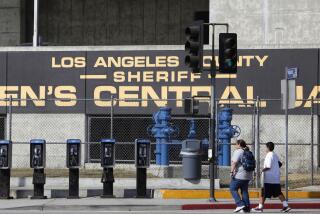County Let 119,577 Out of Jail Early
Admitting they had seriously undercounted the number of jail inmates released early, Los Angeles County sheriff’s officials said Wednesday that over the last 2 1/2 years, 119,577 convicted offenders had been let go before serving their full sentences.
That figure was nearly double the number announced a month ago when Sheriff Lee Baca made the early releases a cornerstone of his unsuccessful campaign to raise the county’s sales tax to pay for more police officers and deputies.
When they began releasing inmates early to save money in June 2002, sheriff’s officials screened prisoners to decide how much time they should serve. But since last year, deputies have released all but the most serious offenders after they served less than 10% of their sentences, officials said.
“They are pretty much walked through the system,” said Sheriff’s Chief Chuck Jackson, who heads the department’s Correctional Services Division. “We’re releasing a whole lot of folks early from L.A. County jail.”
According to the figures, more than half of inmates released early -- 62,090 -- left jail within a day or two, despite having been sentenced up to three months for crimes such as burglary, drunk driving and minor assaults.
The exceptions to the early release policy are that inmates convicted of spousal abuse must serve 50% of their sentences, and sex offenders, child abusers, and anyone sentenced to jail for murder or attempted murder will serve 100%, Jackson said.
Katie Buckland, a spokeswoman for the Los Angeles city attorney’s office, said prosecutors had asked the Sheriff’s Department to notify victims of domestic violence when their attackers were released early, but that in some cases that had not been done.
“They’re released, and they get home, and they’re in a rage,” she said, adding that some victims had been attacked again.
The early releases, which Baca blames on overcrowding and budget cuts, have been criticized by police chiefs, judges and prosecutors, who say that it undermines the most important deterrent to crime.
In recent weeks, the Los Angeles Police Department has begun deploying officers in the jails to keep tabs on repeat offenders they have identified as “predatory criminals” who are about to be released, said Deputy Chief Gary Brennan, who runs the LAPD’s Detective Bureau.
The officers check those scheduled for release so that they can talk to inmates first and then notify officers on the streets that a serious offender is about to get out, Brennan said.
“It puts them on notice that we’re paying attention, but it also puts the local cops in the field on notice,” he said.
The sheriff began releasing inmates after the county Board of Supervisors refused to increase his budget. Baca complained he did not have enough deputies to staff one of the most overcrowded jail systems in the country and began closing detention centers, reducing the capacity of the jail system from 22,000 inmates to 17,500.
A day after Measure A’s failure, the supervisors asked the county’s chief administrative officer and the sheriff to determine how much money would be needed to end the early releases. That report is due early December.
Supervisor Zev Yaroslavsky, who said he was already convinced that the county had to stop the early releases, said the higher numbers released Wednesday did not alter his opinion. He said judges had privately complained to him and some of his colleagues that the releases were undermining the justice system.
Yaroslavsky, along with some other supervisors, has proposed tapping the county’s unanticipated $309-million budget surplus to reopen closed jails. Even so, it will take months, he said, to hire enough staff to ensure that inmates serve their time.
“The credibility of the sentencing process is undermined by prolonging the early release program,” Yaroslavsky said. “Whether it’s 60,000 or 120,000 releases, there shouldn’t be any.”
Jackson said that while recently going over updated figures, he realized that previous tallies of inmates released early had been wrong. The old numbers, he said, did not include the bulk of inmates who were released almost as soon as they were sentenced.
The jail’s computer system, he said, classifies those differently from other inmates who spend a few weeks or months before being released early. When Jackson last month provided Baca with figures showing about 63,000 early releases, he failed to include those inmates.
“It wasn’t intentional by any means,” Jackson said.
Baca said the updated early release figures showed even more clearly the problems caused by about $160 million in cuts to the department’s budget over the last few years.
He said that he had thought last month that the numbers might have been higher, but he insisted that the department never intended to mislead the public.
“I wanted to show the exact number truthfully as it existed,” he said. “I won’t sugarcoat anything.”
Baca said he did not believe that publicizing the higher numbers during the campaign would have provided much of a boost to Measure A, which was backed by 60% of voters but needed two-thirds to pass.
“Look, we have 1,000 murders every year in the county, and that didn’t persuade voters to go to the two-thirds level,” Baca said. “If that doesn’t persuade them, I don’t think that the jail problem number is going to.”
More to Read
Sign up for Essential California
The most important California stories and recommendations in your inbox every morning.
You may occasionally receive promotional content from the Los Angeles Times.











